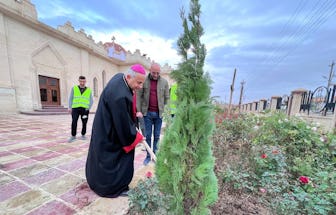
Rebuilding everywhere means planting trees. It is almost instinctual. It is also good, even if nothing has been engineered to accomplish it all.
I have seen my share of design systems at work, and they suffer from unnatural maintenance inputs. Here it all pretty well depends on an available root space and whatever local water is available.
It is unfortunate that sewage flow cannot be locally processed to provide usable water.
HOW TREES ARE HELPING THIS WAR-TORN CITY HEAL AFTER ISIS
When the terrorist group occupied Mosul, the “Green City” turned gray. One local blogger was determined to reverse the damage.
Courtesy of Mosul Eye
"THE BEST REPRESENTATION OF LIFE"
7.10.2022
https://www.mic.com/impact/green-mosul-trees-isis?
Suad Jassim remembers the terror she felt when ISIS first occupied her city. The extremist group captured Mosul in northern Iraq in 2014 and occupied it for three years. By 2017, intensive bombing had destroyed about 65% of the city’s buildings. “We weren’t even able to leave the house,” Jassim, 48, says. “We were living in fear.”
Mosul had once been known as “the Green City.” Trees had lined the avenues; there were forested valleys. But the intense warfare during ISIS’s occupation ravaged much of this vegetation. “ISIS cut some of the trees. Otherwise they were ignored,” says Abdullah Al-Dabbagh, chief gardener at Mosul’s Northern Technical University. “Nobody took care of them and they died. Life stopped.” Pollution, desertification, urban expansion, and flooding also played their part. By 2021, the Green City had turned gray.
But Jassim, a manager at Mosul’s train station, noticed a change towards the end of 2021. New trees began appearing in districts across the city — along the streets, in the old forests, beside public buildings. Mosul was re-greening.
The transformation wasn’t a mind trick. There were indeed new trees popping up in the city, planted as part of a new initiative led by the Mosuli social organization Mosul Eye. Mosul Eye had started as a blog run by an anonymous Mosuli who wanted to spread news about life under ISIS rule. The site posted news updates about drone strikes and mass executions, as well as analyses of ISIS propaganda. It eventually grew into a full team promoting social initiatives across the city.
Mosul Eye’s anonymous blogger later revealed himself to be Omar Mohammed, a historian who now teaches at Sciences Po in Paris and the George Washington University in Washington, D.C. Mohammed’s team started planting the trees in November 2021 to revive their city after ISIS’s defeat in 2017. Mohammed also wanted to rebuild the trust between the city’s various ethnic communities, which the religion-based conflict had crushed. The project became known as Green Mosul.
Aerial photos show the difference in tree cover over time in Mosul.
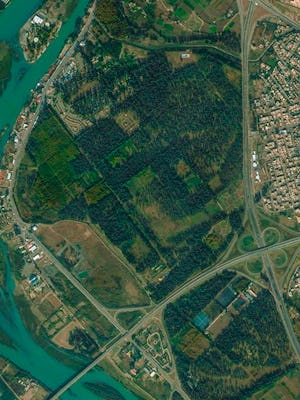
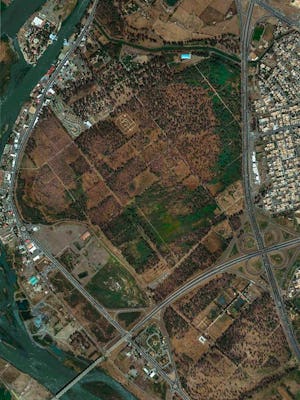
“When you lose social trust, the community will not develop,” Mohammed tells Mic. People of differing identities and faiths would plan indirect routes avoiding specific areas when traveling across the city, he says. They wouldn’t speak to any strangers. “Trust will stop and freeze at one level,” he continues, “and the only thing that will actually grow is hate, because they are not speaking to each other. They are not talking over their problems and they are left to their own fears.”
After reviewing other post-conflict reconciliation projects around the world, Mohammed and his team decided to focus on tree planting. They felt it would provide a good way to bring people together in Mosul, because the act of planting provided a cause every community could feel invested in. At the same time, the goal of rebuilding bonds between communities was never explicitly stated, which increased the likelihood of Mosulis agreeing to participate, according to Mohammed. Re-greening Mosul would also help Mosul progress from the status of “post-conflict city,” the team figured, by contributing to the world’s fight against climate change.
The Mosul Eye team originally planned to plant 5,000 orange, cypress, lemon, and pine trees around the city between November 2021 and February 2022. Mosuli nurseries would provide the trees with funding from the French government, and the team would recruit volunteers from every district to help plant them.
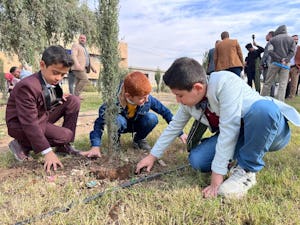
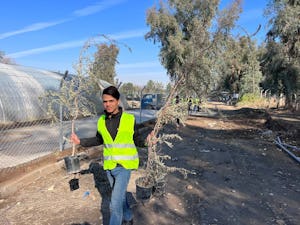
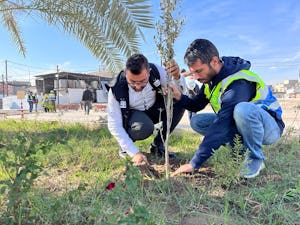
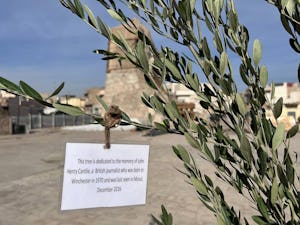
But after Green Mosul went public that November, the turnout astonished even Mohammed. Instead of the planned 5,000 trees, Mosulis planted 17,000 new saplings around their city. For Jassim, the Mosuli train station manager, this meant a return to the city closer to the Mosul she once knew. “Seeing greenery around you will always be better than not seeing greenery,” she tells Mic. “After Green Mosul came, people started being more open and positive. The grass was green and the land was open once again.” The planting campaign even went viral among university staff and students, according to Al-Dabbagh, the gardener.
Mohammed had feared some communities, like the Yazidis, would be impossible to reach because of the trauma they experienced during ISIS’s occupation. Now, four of Green Mosul’s beneficiary communities are located in Sinjar, the Yazidis’ heartland. “I have never seen people come together this way,” he says. “I realized that yes, trees actually bring people together.” Muslims planted trees in church gardens and Yazidis planted trees beside mosques.
“No one asked, ‘What is the religion of this tree?’” Mohammed says. “In my opinion, it’s the best representation of life.”
Mohammed noticed soldiers helping to plant trees too. This symbolized a drastic change from the previous atmosphere of fear, when people would avoid eye contact with soldiers in the street. “That is a good sign to me,” Mohammed explains. “It is no more about ‘rulers’ and ‘ruled people.’ No, they realize that we are together in this.”

The psychological effect of trees on the human mind is evident elsewhere too. One recent study in Tokyo, Japan, revealed that people with views of trees and access to green spaces during the pandemic experienced lower levels of depression and higher levels of self-esteem. This idea is referenced in popular culture too, with believers of the “Old Gods” in Game of Thrones using a fictional “weirwood” tree as a shrine.
The roots of this relationship are obscure, but they may relate to the extensive health and environmental benefits trees provide. They also absorb carbon dioxide, support biodiversity, and filter fine particles like dust, which is becoming an increasing health issue in Iraq. Their ability to regulate water flow prevents floods, and their presence can cool surrounding air by as much as 8 degrees Celsius (about 46 degrees Fahrenheit).
Joe McBride, a professor of landscape architecture and environmental planning at the University of California at Berkeley, has been studying the influence of re-greening initiatives in post-conflict cities for over 40 years. One thing that he’s observed across various re-greening projects is that the volunteering aspect plays a particularly important part in a city’s revival. Following World War II, for example, St. Petersburg University in Russia organized groups of high-school students to help replant trees.
“This gave those kids an amazing sense of pride,” McBride tells Mic. “They could see that they had done something to really put the city back into a better, more livable condition.” McBride interviewed a student who had been involved in that project in 2005, and he says many of them remained connected with the trees their entire lives, later introducing their grandchildren to them. The Mosul Eye team hopes Green Mosul will achieve the same generational effect.
“WHEN WE PLANT TREES, AND WE TAKE CARE OF THEM, WE MAKE A BIG DIFFERENCE TO THE CITY.
Of course, all of this hinges on having trees to plant. But acquiring those trees can prove challenging. Tokyo’s post-WWII government, for example, rushed to plant whatever trees were available. It then returned five years later to replace them with trees of the original species that had existed before the war; Hiroshima’s government had asked local farmers for donations. Mosul Eye faced this challenge too, but they were able to adapt: “Reaching a balance between what type of trees are suitable for people’s areas and what can provide shade and better air quality helped us convince them to look at the trees as a new opportunity to develop their areas, despite how they looked before,” he says.
For Green Mosul, Mohammed felt it would be important to source the trees from local nurseries and use local advisers. The project had to represent the city’s own strength and revival; external support would be limited to funding only, rather than supply. But even that monetary support may soon no longer be needed. Mosul’s regional government has now announced it will allocate 7% of its annual budget to continue re-greening the city. Mohammed says he is also talking to representatives at USAID and UNESCO about continuing the initiative in 2023. Several U.S.-based organizations have also contacted him for help in replicating the concept in three other post-conflict cities, he says (though he told me he couldn’t say which).
Isen Samir, a 23-year-old Christian beekeeper from Mosul’s suburbs, had to escape when ISIS attacked Mosul. The situation had been particularly dangerous for people of his faith. When Mosul Eye requested volunteers to plant trees for the Green Mosul project, Samir saw it as an opportunity to contribute to his city. The experience even encouraged him to start planting his own eucalyptus trees, which provide good forage for honey bees.
“Mosul was destroyed because of ISIS,” he tells Mic. “When we plant trees, and we take care of them, we make a big difference to the city. We need to keep going, and keep taking care of our trees. I want to continue this journey.”
No comments:
Post a Comment